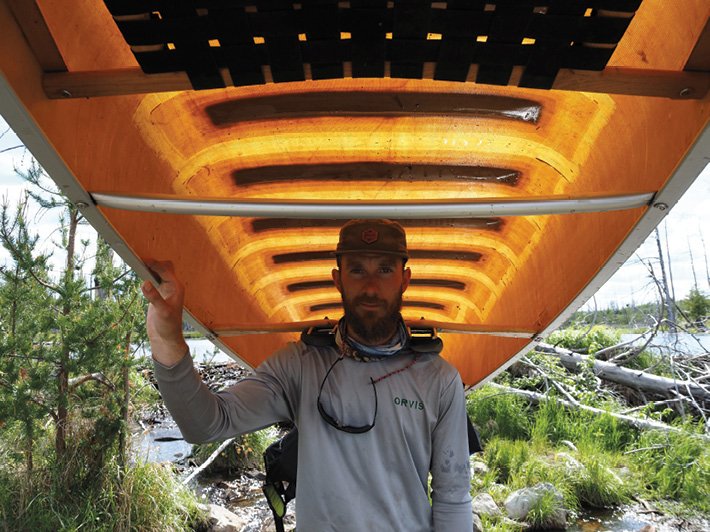As temperatures continue to cool along the North Shore and the tamarack drop their needles in fall’s final golden display, another canoe season in the Boundary Waters Canoe Area Wilderness comes to a close. And, wow, was it ever an exciting one.
According to a number of outfitters in the Gunflint region of the BWCAW, 2021 was a wild, busy season made all the more challenging by one of the worst droughts in recorded history and the numerous fire-related closures that came about as a result.
“The 2021 season was just as busy, if not busier than the crazy season last year,” says Matthew Ritter who co-manages Voyageur Canoe Outfitters at the end of the Gunflint Trail with his wife Cassidy. “Like most outdoor rec and tourism businesses, we had a record year last year, but we seem to have passed those stats this summer, which we thought impossible.”
Despite weeks of lockdowns and a delayed opening of the BWCAW in 2020, the previous season saw a huge growth in the number of visitors to the wilderness, with a 16 percent increase in annual visitors over the previous year according to the Forest Service’s Boundary Waters Canoe Area Wilderness Superior National Forest Permit & Visitor Report 2016-2020.
Hand in hand with the increased number of visitors in the BWCAW in 2020 was a 25 percent increase in permits issued during the quota season from May 1 to Sept. 30 over the previous year. Increased demand for permits has made permits harder to come by, especially for some of the more sought-after entry points.
“As an outfitter,” adds Ritter, “we look at permits daily, and in the past two years they have gotten harder and harder to come by. I don’t think the park has ever seen this amount of pressure or traffic.”
“We used to only have issues booking permits once we got into the busy season in July and August,” continues Ritter. “Now, we encourage people to get things planned and booked as soon as they can, especially if they have a specific entry point in mind. On a number of occasions over the past two years we have seen the park running at 100 percent capacity, something I can say has not happened in my time at VCO before the pandemic.”
Updated statistics for the 2021 season will be released by the Forest Service later this coming spring once they have had the opportunity to collect all of the self-issue permits from the entry point/trail head permit boxes in late fall, winter and early spring.
The 2021 BWCAW canoe season seems to have been similar to last year in how busy it was. However, 2021 was different in a couple of significant ways from the 2020 season, namely with in-person permit issuing and the consequences of severe drought.
This year marked a full return to in-person BWCAW permit issuing, a dramatic change from the remote online permit issuing process that the Forest Service was forced to adopt last year during the pandemic.
“The Forest Service is dedicated to in-person issuance into the future,” says Ann Schwaller, forest program manager for the Boundary Waters Canoe Area Wilderness. “In-person issuance is always a better educational experience and allows visitors to connect/ask those important questions.”
“We hope to have our doors open next year with regular hours,” continues Schwaller, “but it’s hard to predict what this virus will bring to all of us or the direction from the Department of Agriculture and Forest Service.”
According to Schwaller, “resource damage” is always a serious concern in a wilderness area that is as heavily used as the BWCAW. In-person permit issuance definitely helps educate visitors on proper wilderness travel etiquette, but with more and more people visiting wilderness areas since the onset of the pandemic it has become even more crucial that visitors enjoy the park responsibly.
While physical damage such as vandalized green trees and garbage is an ongoing issue for the Forest Service, “social damage” is another, perhaps lesser-known, impact visitors can have on the wilderness.
“Social damage is something visitors don’t always consider,” says Schwaller, “like playing music from blue tooth speakers, screaming, singing, dragging canoes over rocks, lack of portage etiquette, and lighting up campsites at night.”
“Noise and artificial bright light,” continues Schwaller, “can be just as much of an impact as other types of damage in the wilderness.”
A good resource for leave no trace and tread lightly information is the Forest Service’s Trip Planning Guide, which can be found online at: bit.ly/tripplanningguidefs.
With regards to the drought’s impact on the 2021 season, low water levels had a definite impact on the accessibility of certain parts of the BWCAW, while limited food resources for bears played into an uptick in bear activity for the season.
Then, of course, certain entry points were closed throughout the season in response to fire activity.
“The drought caused dangerous conditions unlike anything we’ve seen in recent history,” says Schwaller. “At times, we had to choose safety from wildfire over recreational access.”
Further information on the BWCAW and Superior National Forest can be found on the Forest Service’s website at: fs.usda.gov.






